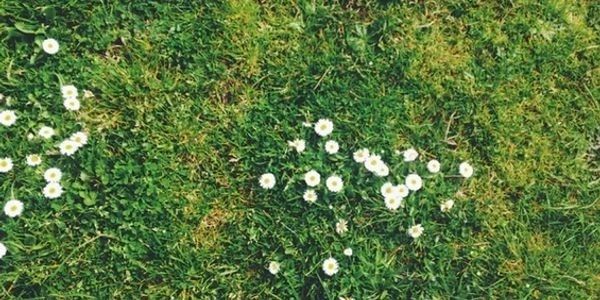
Grassy Weeds
ANNUAL BLUEGRASS
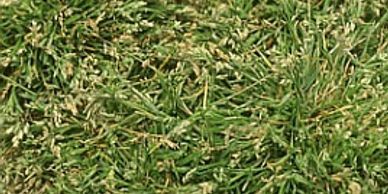
Annual bluegrass contains both annual and perennial species. Annual bluegrass forms dense patches that can withstand low mowing heights. Annual bluegrass has a boat-shaped tip, folded in the bud. The ligule is membranous and auricles are absent. Annual bluegrass has a small panicle seedhead. Germination occurs in late summer and early spring.
ANNUAL SEDGE

Green Kyllinga is a perennial sedge. It is capable of forming dense mats due to its development of rhizomes. The leaves are dark green and grow up to 6 inches in height. The seedhead is round and has three leaves below it. Green Kyllinga spreads by both seeds and rhizomes.
BAHIAGRASS
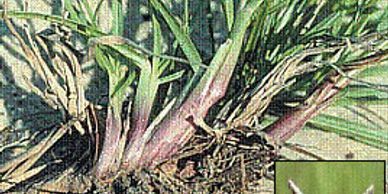
A coarse-textured warm-season perennial (C-4) which does not form a tightly knitted turf. Bahiagrass has a rolled vernation, ligules which are membranous in nature with short hairs on the back of the ligule. Auricles are absent and the sheath is flattened. The leaf blades are coarse, light green in color, pointed at the tip and sometimes have hairs located near the base. The blades are typically folded near the base. Leaf blades are very fibrous and difficult to cut cleanly, causing them to fray and give turf a rough appearance. Bahiagrass has an extensive deep root system and is very drought tolerant. Bahiagrass is often identified by the distinctive “V” shape (see seedhead insert) created by the 2 slender spiked racemes (sometimes there are three, but not often) with two rows of oval seeds. The tall seed stalks are a problem due to their rapid growth and require constant mowing in fine turf. Bahiagrass produces seedheads from June through November. Bahiagrass reproduces from seed and from short rhizomes and stolons which are so stout they are almost woody. Since old leaf sheaths persist at the base, they tend to have a woody appearance as well.
BARNYARDGRASS

Barnyardgrass is a summer annual which has tillers which lie flat and form secondary roots resulting in a mat formation. The leaves of barnyardgrass are rolled in the bud and contain neither a ligule nor auricles; the sheath is open but compressed. The mid-vein is thick and keeled; roots are fibrous.Barnyardgrass spreads by seed which germinate in late spring and early summer. The seedhead is a coarsely branched green to purplish panicle with spiked awns.
BERMUDAGRASS

Bermudagrass is creeping perennial warm-season (C-4) turfgrass. Bermudagrass spreads by both rhizomes and stolons. Bermudagrass is grown as a fine turf throughout the transition zone and in the South. The ligule consists of a fringe of hair. Auricles are absent. The leaves of bermudagrass are folded in the bud, and the sheath is strongly compressed. The leaf is short, approximately 1/8 inch wide with rough edges. The roots of bermudagrass are deep and fibrous allowing it to be highly drought tolerant. The stolons root at the nodes forming a thick dense mat. The seedhead of Bermudagrass consists of 3 – 7 finger-like spikes. Seedheads are present during the summer months. Common bermudagrass can spread by seed, but hybrid varieties only spread by vegetative means. Bermudagrass is found on open sunny areas. Bermudagrass does not grow in the shade. It can be found in turf, landscapes and in most cultural crops. Bermudagrass is very tolerant of low mowing, and can be found on both dry and wet soils.
CRABGRASS

Crabgrass is a summer annual that germinates when soil temperatures reach a consistent 55 degrees F and is generally killed at the first frost. Crabgrass leaves are rolled in the bud; the first leaf appears short, wide and blunt-tipped. The ligule is tall and membranous with jagged edges, and the auricles are absent. The collar is broad with long hairs. Crabgrass is light green in color, coarse bladed and will root at the nodes when they touch the ground. A single crabgrass plant can produce up to 700 tillers. It is a bunch type grass. The inflorescence is a panicle of branches, with spikelets in two rows. A crabgrass plant can produce 150,000 seeds. Crabgrass needs warm soils and sunlight to germinate.
BARNYARDGRASS
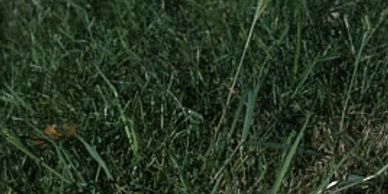
Barnyardgrass is a summer annual which has tillers which lie flat and form secondary roots resulting in a mat formation. The leaves of barnyardgrass are rolled in the bud and contain neither a ligule nor auricles; the sheath is open but compressed. The mid-vein is thick and keeled; roots are fibrous.Barnyardgrass spreads by seed which germinate in late spring and early summer. The seedhead is a coarsely branched green to purplish panicle with spiked awns.
BERMUDAGRASS
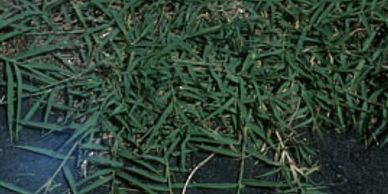
Bermudagrass is creeping perennial warm-season (C-4) turfgrass. Bermudagrass spreads by both rhizomes and stolons. Bermudagrass is grown as a fine turf throughout the transition zone and in the South. The ligule consists of a fringe of hair. Auricles are absent. The leaves of bermudagrass are folded in the bud, and the sheath is strongly compressed. The leaf is short, approximately 1/8 inch wide with rough edges. The roots of bermudagrass are deep and fibrous allowing it to be highly drought tolerant. The stolons root at the nodes forming a thick dense mat. The seedhead of Bermudagrass consists of 3 – 7 finger-like spikes. Seedheads are present during the summer months. Common bermudagrass can spread by seed, but hybrid varieties only spread by vegetative means. Bermudagrass is found on open sunny areas. Bermudagrass does not grow in the shade. It can be found in turf, landscapes and in most cultural crops. Bermudagrass is very tolerant of low mowing, and can be found on both dry and wet soils.
CRABGRASS
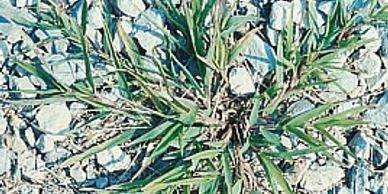
Crabgrass is a summer annual that germinates when soil temperatures reach a consistent 55 degrees F and is generally killed at the first frost. Crabgrass leaves are rolled in the bud; the first leaf appears short, wide and blunt-tipped. The ligule is tall and membranous with jagged edges, and the auricles are absent. The collar is broad with long hairs. Crabgrass is light green in color, coarse bladed and will root at the nodes when they touch the ground. A single crabgrass plant can produce up to 700 tillers. It is a bunch type grass. The inflorescence is a panicle of branches, with spikelets in two rows. A crabgrass plant can produce 150,000 seeds. Crabgrass needs warm soils and sunlight to germinate.
DALLISGRASS
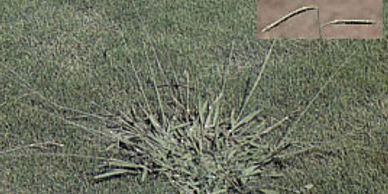
Dallisgrass is a warm season coarse perennial which is light green in color. The leaves are rolled in the bud, flat and wide (1/2″). Auricles are absent and the ligule is tall, pointed, and membranous. Dallisgrass has hairs on the lower portion of the leaf near the ligule. The seedhead contains 3 – 6 spikes, with seeds on both sides of the spike. Dallisgrass can from short thick rhizomes, but spreads upright in clumps. This highly invasive plant germinates in soil temperatures of 60 to 65 degrees F and thrives in the hot humid conditions of the southern states.
DOWNY BROME
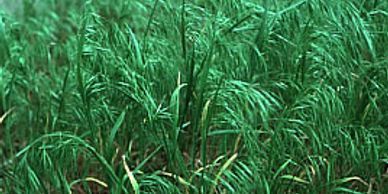
Downy Brome is a winter annual grass that has an upright growth habit. The leaves lack auricles. Downy brome has a large jagged membranous ligule. The leaves are rolled in the bud and are hairy on both sides. The seedhead is very predominate in that it has a droopy panicle. It seeds from late spring into the summer. Downy brome dries over the summer and can become a fire hazard.
GOOSEGRASS
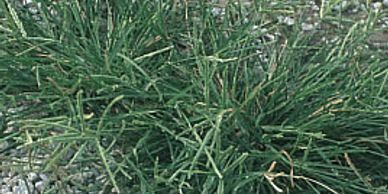
Goosegrass is a prostrate-growing summer annual. The leaves are folded in the bud. Goosegrass grows in a clump with the base of the leaves being distinctively white to silver in color. The ligule is toothed, membranous, and divided at the center. Goosegrass contains hairs only at the base of the leaf. Goosegrass seedheads contain 3 -7 spikes that form at the tip of the seed stalk. The seeds are attached in a zipper appearance on the spike. Goosegrass spreads by seeds that germinate later in the season than other annual grasses.Goosegrass seedheads contain 3 -7 spikes that form at the tip of the seed stalk. The seeds are attached in a zipper appearance on the spike. Goosegrass spreads by seeds that germinate later in the season than other annual grasses.
KIKUYUGRASS
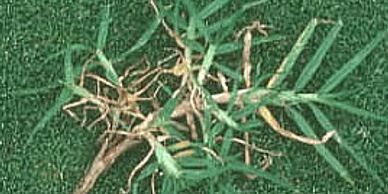
Kikuyugrass is a low-growing perennial grass. It contains both rhizomes and stolons. The stolons have short internodes. The leaves are folded in the bud, the ligule consists of a fringe of hairs, and auricles are absent. The seedhead is inconspicuous and located in the stem of the node. Filaments formed in the early morning cause a white cast to the turf.
ORCHARDGRASS
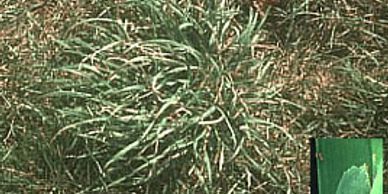
Orchardgrass is a perennial grass that is blue-green in color. The leaves are folded in the bud, the ligule is very tall membranous, and auricles are absent. Orchardgrass only contains tillers, resulting in clumps. Orchardgrass can tolerate close mowing. The roots are very fibrous and dense. Orchardgrass remains green throughout the year. The seedhead is a stiff-branched panicle. Seedheads occur from late spring through midsummer.
SEDGES
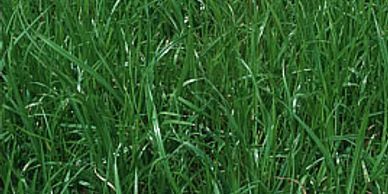
Sedges have triangular stems with waxy grass-like leaves which alternate. Sedges are not grass plants, but seedlings may be mistaken for grass. The leaves on both sedges are waxy and have an up right growth habit and a prominent midrib. Both sedges have underground root systems containing rhizomes and underground tubers which accomplish most of the reproduction. On yellow nutsedge, the tubers (nutlets) form at the end of whitish rhizomes. Purple nutsedge forms chains of tubers along brownish rhizomes. The flowers of yellow nutsedge are yellowish; the seedhead color of purple nutsedge is red-purple to brown. Both seedheads are on triangular stems. Both spread mainly by germinating underground tubers, which are the only part of the plant that over-winters. A yellow nutsedge tuber can produce 1,900 plants and 7,000 new tubers in a single growing season1. Sedges do well where soil has poor drainage.
